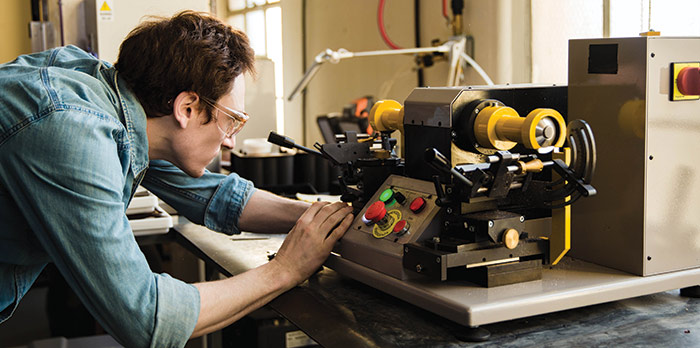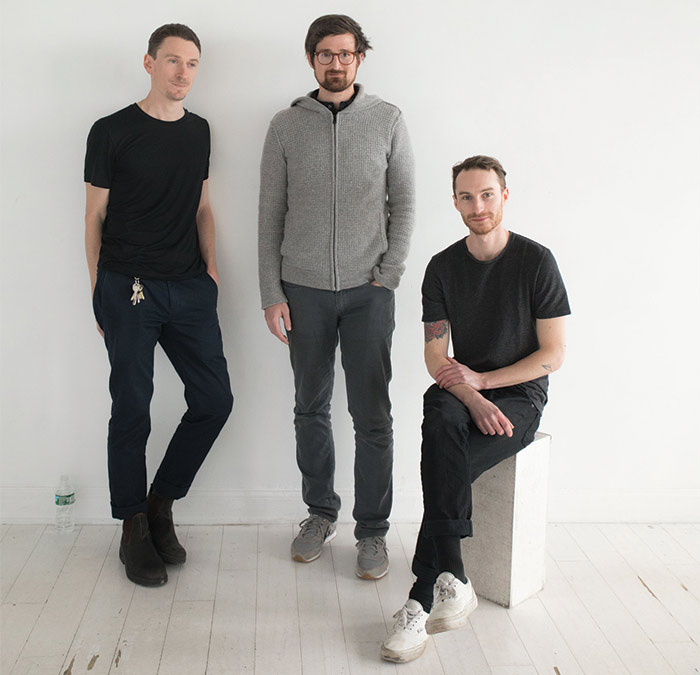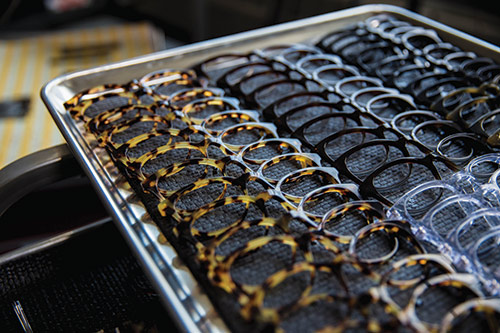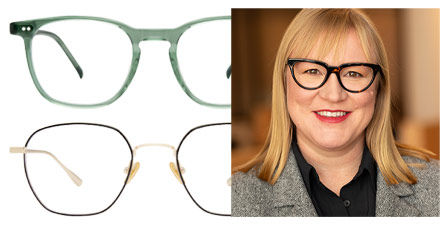
By Victoria Garcia
It takes great courage and determination to take a dream and turn it into a reality. It is even more inspiring when this vision is based upon a rare concept nearly snuffed until recent valiant efforts. Brian Vallario and Gerard Masci decided to take a risk and venture into the world of eyewear without any formal training or contacts in the industry. What made their leap of faith even more impressive? They wanted all of the eyewear they created to be made right here in the United States.The idea for Lowercase began when Masci was searching for his next endeavor in life after leaving his job on Wall Street. “I began to explore eyewear as it has been a lifelong passion of mine since I started wearing frames at 12 years old,” says Masci. “After doing some research on the industry, it was quickly apparent that almost nobody was making frames in the U.S. anymore, which intrigued me. With consumers increasingly looking for local products that provide transparency into their process and have a story to tell, I thought there was a place for a vertically integrated brand based in New York City.”

From left: Ryan Langer, Gerard Masci and Brian Vallario
With Masci’s background in finance, he needed to find someone with experience in creating and manufacturing product. A mutual friend put him in touch with Vallario, whose architecture experience would be a perfect fit. “I had always grown up working in factories,” says Vallario. “I was itching to get out from behind a computer and make something again. Basically after one meeting I said I want to do this with you, and we teamed up that day.”
Established in 2016, Lowercase is the product of Vallario and Masci’s desire to create quality frames and localize the trade of eyewear. Their workshop is located in the historic Brooklyn Army Terminal and comprises 2,000 square feet filled with impressive machinery and five employees, including Masci and Vallario. “The Brooklyn Army Terminal is actually the first place we looked at, but a space didn’t open until a year later,” says Masci. “Looking for a relatively small space that can handle heavy equipment, has running water and heavy power is surprisingly difficult to find. We really lucked out because the Brooklyn Army Terminal has a history behind the building and is as great as any building in New York City.”
The difficulty in manufacturing eyewear in the United States is the availability of materials and machinery used to produce frames. Eighty percent of the machinery found in the Lowercase work space derives from Italy, where the two traveled to immerse themselves in the manufacturing process. “When Gerard and I first started, we went out there,” says Vallario. “We were never able to tour the factories but we were able to meet with the manufacturers of the machinery.” All of the materials used to produce each Lowercase frame are imported from different areas of the world. The acetate is sourced from Italy and Japan, while the hinges are German engineered, and all of the sun lenses are from Carl Zeiss. Once the duo figured out how to acquire the materials and machinery needed, they brought on Ryan Langer, the brand’s current head craftsman. “I’m not a craftsman by trade so Ryan is one of the craftsman I worked with previously in architecture,” says Vallario. “He really took it to the next level, in terms of the quality we were able to produce.”
The machinery found throughout the brand’s small space is extremely impressive for a relatively new company. Vallario masterfully explains the 30-step process of producing a frame, which from start to finish takes about two weeks. The buzz of machinery fills the air while temples, frame fronts and acetate blocks and shavings can be seen in various stages across the work space. From curing the acetate, using a CNC machine with a robotic arm, placing frames in the barrel tumbler to polish, stamping logos on the temples and inserting core wires, every step of the production process is done within the work space, alongside the craftspeople who use traditional methods and hand-finishing techniques to shape, polish and perfect each frame. “We do small batches,” explains Vallario. “We basically run a couple hundred a week, and that’s our sales capacity at the moment. The polishing takes so long so if we want to up capacity, we would need to hire more people for polishing because it takes so much longer than any other step of the process.”

The mere fact that each frame is personally handled and cared for by an artisan is what sets Lowercase apart from many other eyewear brands, and what originally drew both Masci and Vallario to start the business. “We wanted to build a vertically integrated business,” says Vallario. “It is important for us to have control over the production process and quality, not just design frames and send them overseas to be made.” The importance of personally constructing each frame is especially apparent when presented with the final product. The high-gloss finish, hand polished details and bright acetate flawlessly represents what Lowercase is all about. “We just love making things, and we will never outsource,” says Vallario. “Obviously, we can’t make the acetate, we can’t make the lenses but as far as start to finish with frame making, we will never outsource any part of that. But we want to make, that’s what drew us into this business.”
All sunwear and optical frames are constructed with imported acetate and are stamped with the brand’s logo and “Made in NYC” on the inside temples. There are currently 150 SKUs available, and 20 more will be added this month. “For each collection we release, we choose a category that is New York City centered, such as parks, poets and music venues,” says Masci. One of the brand’s best-selling frames, the Marlton is named after the Marlton Hotel where Vallario and Masci first met to discuss the idea of Lowercase. “Our Roseland, Irving and Vanguard styles all drew inspiration from iconic music venues in New York City. Sometimes our inspiration can come from a color palette or movement in music.” All of this constant frame production creates a large amount of acetate waste, which the brand is attempting to recycle into various products. “We’ve started making combs out of the scrap pieces that are large enough,” says Masci. “But we would love to recycle our smaller waste into new tablets in order to make a fully recycled frame.”
With Made in America as the core of their ideology, Lowercase is focused on creating relationships and collaborations with other brands that share the same philosophy. Being a small batch factory, this easily allows for limited edition pieces to be created in small quantities. The company has worked with various designers and brands to design several collaboration pieces. “When we collaborate with people, it’s always focused around other brands that are making products in the U.S. so there’s a common thread that binds us all,” says Vallario. Their first collaboration was with men’s brand Knickerbocker. They redesigned a frame called the RPG, which was based off the regulation prescription glasses from the Army in the ’70s. Another recent collaboration was designed with the women’s swimwear brand New Swim, where they created ’50s swimwear inspired optical and sunwear styles that have become best sellers. A unique collaboration they recently designed was with the Brooklyn Museum. “We were surprised to receive a call from them regarding their upcoming show on Pierre Cardin,” explains Masci. “They asked us to look through his archives and gave us free reign to design from whatever inspiration we found from our research. Brian found a beautiful desk clock that he used as inspiration for the frames.” The 200 frame style was produced in limited quantities and is carved from 8 mm acetate in a circular shape with layers of transparency that create a unique and one-of-a-kind piece.
With a few more collaborations on the horizon, Lowercase is focused on getting their story heard around the world. They plan on adding new styles, design details and manufacturing techniques such as laser engraving and matting frames, to take their process to a different level. “We will always invest in our manufacturing, as that is where our passion lies,” explains Masci. “We will always be a small team, with a highly curated offering and an open door policy to show our process. While our styles and colors will surely evolve over time, I don’t expect our core to change much.” So far, these core principles have led them to create eyewear that stands apart from the rest and tells their unique story while bringing back the heritage of eyewear to the United States, a characteristic that many consumers are on the lookout for. ■












